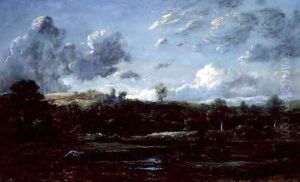Dupre, Jules Rousseau, Etienne & Paintings
Jules Dupré was a prominent French painter, associated with the Barbizon school, who played a pivotal role in the development of landscape painting in the 19th century. Born on April 5, 1811, in Nantes, Dupré began his artistic career in his father's porcelain factory, where he gained an early appreciation for the nuances of color and texture. This early exposure to art and craftsmanship laid the foundation for his lifelong pursuit of painting, particularly landscape painting, which would eventually distinguish him as one of the foremost artists of his time.
Dupré's work is characterized by a dynamic and emotive treatment of nature, often focusing on the skies, seas, and rural landscapes. His approach combined the realistic observation of nature with a dramatic, sometimes almost tempestuous, use of color and light, setting his work apart from that of his contemporaries. In the 1830s, after moving to Paris, Dupré's talent quickly garnered attention, leading to his participation in the Salon, the official art exhibition of the Académie des Beaux-Arts in Paris. His paintings from this period reflect his fascination with the landscape and its capacity to evoke emotional and spiritual responses.
Throughout his career, Dupré maintained a close association with other Barbizon painters, including Théodore Rousseau and Jean-François Millet, sharing with them a deep commitment to portraying the natural world. Unlike many of his contemporaries who focused on idealized, classical landscapes, Dupré sought to capture the raw, unembellished beauty of the French countryside, often portraying it under dramatic and changing weather conditions. This pursuit not only marked a significant shift in the landscape genre but also prefigured the Impressionist movement, which would further revolutionize art in the late 19th century.
Dupré's later years were marked by both critical and commercial success, as his paintings were sought after by collectors in France and abroad. Despite this, he lived a relatively secluded life, devoted to his art and the landscapes that inspired it. Jules Dupré died on October 6, 1889, in L'Isle-Adam, leaving behind a legacy that significantly influenced the course of French painting. His work continues to be celebrated for its pioneering approach to landscape art and its profound impact on the generations of artists that followed.
